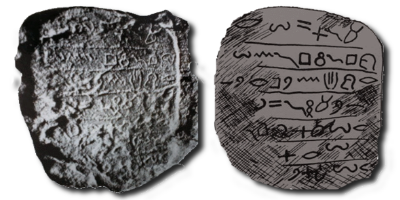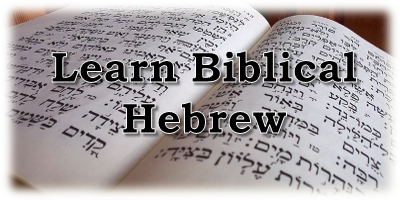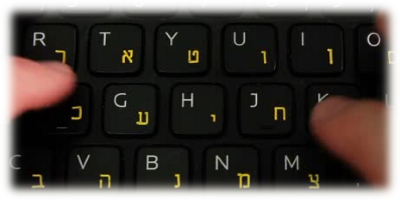The ancient Hebrew alphabet has very little resemblance to the modern Hebrew alphabet, though the modern did evolve out of the ancient. The ancient twenty-two Hebrew letters were originally pictures of animals, tools or parts of the body.
The objective of this page is to teach the name, sound and meaning of each letter by associating it with common English words and sounds that are related to the original Hebrew. This will allow for an easier method of learning the ancient Hebrew alphabet.
Let us take the Hebrew letter  as an example. The picture of this letter is a house or tent. We will associate this letter with "bed" and has a "b" sound. The next step is to transfer the name and sound to the actual Hebrew name which is beyt with a "b" sound. In the third step we will learn that the beyt has the meaning of "house, tent, inside and with."
as an example. The picture of this letter is a house or tent. We will associate this letter with "bed" and has a "b" sound. The next step is to transfer the name and sound to the actual Hebrew name which is beyt with a "b" sound. In the third step we will learn that the beyt has the meaning of "house, tent, inside and with."
Once the letters are understood in their original Hebrew context, we will look at a few Hebrew words which are formed by combining letters together. The meaning of these letters will then help to supply the definition to the Hebrew word.
The Ancient Hebrew Alphabet
Click on the ancient letter to go to that letter. For a more detailed chart go here.
| Hebrew | Name | Sound |
|---|---|---|
 | Aleph | a, e |
 | Beyt | b, bh |
 | Gimel | g |
 | Dalet | d |
 | Hey | h, e |
 | Waw | w, o, u |
 | Zayin | z |
 | Hhet | hh |
 | Tet | t |
 | Yud | y, i |
 | Kaph | k, kh |
 | Lamed | l |
 | Mem | m |
 | Nun | n |
 | Samehh | s |
 | Ayin | ah |
 | Pey | p |
 | Tsade | ts |
 | Quph | q |
 | Resh | r |
 | Shin | sh |
 | Taw | t |
 | Ghayin | gh |

This is a picture of the head of an ox, the strongest and most versatile animals among the Hebrews livestock. The ox was used to pull carts or a plow, it provided meat and leather and it was one of the animals used in sacrifices. This animal was the "all" powerful and "all" versatile animal of the Hebrews. This letter has an "a" sound, but also an "e" sound as in elk and elephant, both of which are also powerful animals. The name of this letter is "aleph," which may be the origin of "elephant."
Picture: Ox
Associations: All, elk, elephant
Sound: a (ah), e (eh)
Ancient Name: al or el
Modern Name: aleph
Modern Form: א
Meaning: strong, power, leader
Additional historical and detailed Information on this letter

The Hebrews lived in goat hair tents, which were divided into two halves, male and female sections, and divided by a wall. The picture of this letter is a representation of the floorplan to the tent. The tent was the place where the family laid their "bed".
Picture: Tent
Associations: Bed
Sound: b, bh (v)
Ancient Name: Beyt
Modern Name: Beyt
Modern Form: ב
Meaning: Family, House, In
Additional historical and detailed Information on this letter

The picture is the foot of a man. The Hebrews were always on their feet for traveling, working as well as playing "games". The old Latin word for a leg is "gam."
Picture: Foot
Associations: Game, Gam
Sound: g
Ancient Name: Gam
Modern Name: Gimel
Modern Form: ג
Meaning: Gather, Walk
Additional historical and detailed Information on this letter

The entrance of the Hebrew's tent was covered by a curtain suspended from a horizontal pole. The picture of this letter represents the "door" of the tent.
Picture: Door
Associations: Door
Sound: d
Ancient Name: Dal
Modern Name: Dalet
Modern Form: ד
Meaning: Move, Hang, Entrance
Additional historical and detailed Information on this letter

The picture is of a man with his arms outstretched, pointing toward a wonderful view and saying "hey" look at that.
Picture: Pointing
Associations: Hey
Sound: h, ey
Ancient Name: Hey
Modern Name: Hey
Modern Form: ה
Meaning: Look, Reveal, Breath
Additional historical and detailed Information on this letter

The tent was supported by ropes attached to pegs driven into the ground. These pegs were made of a branched piece of hardwood. No English word is derived from this letter but the picture is similar to the hand of a man "waving".
Picture: Peg
Associations: Wave
Sound: w, ow, uw
Ancient Name: Waw
Modern Name: Vav
Modern Form: ו
Meaning: Add, Secure, Hook
Additional historical and detailed Information on this letter

The picture is of a mattock, an agricultural tool for working the crop fields. There is no English word derived from this Hebrew letter but it is similar to the letter "Z", which did evolve out of this letter.
Picture: Mattock
Associations: Z
Sound: z
Ancient Name: Zayin
Modern Name: Zayin
Modern Form: ז
Meaning: Food, Cut, Nourish
Additional historical and detailed Information on this letter

The tent was divided into two sections, with a wall separating the tent in "half".
Picture: Wall
Associations: Half
Sound: h
Ancient Name: Hhet
Modern Name: Hhet
Modern Form: ח
Meaning: Wall, Outside, Divide, Half
Additional historical and detailed Information on this letter

The picture is a basket or "tote" used for storing foods or belongings.
Picture: Basket
Associations: Tote
Sound: t
Ancient Name: Tet
Modern Name: Tet
Modern Form: ט
Meaning: Surround, Contain, Mud
Additional historical and detailed Information on this letter

The picture is of the hand and arm of a man. The length of the arm, from fingertip to elbow is called a cubit. Our word "yard", as a measurement, is the length of the arm.
Picture: Hand
Associations: Yard
Sound: y, ee
Ancient Name: Yad
Modern Name: Yud
Modern Form: י
Meaning: Hand, Work, Throw, Worship
Additional historical and detailed Information on this letter

The picture is the open palm of the hand. The palm facing up and bent forms a "cupped" shape.
Picture: Palm
Associations: Cup
Sound: k
Ancient Name: Kaph
Modern Name: Kaph
Modern Form: ך כ
Meaning: Bend, Open, Allow, Tame
Additional historical and detailed Information on this letter

The Hebrews raised sheep for wool, food, leather and milk. The Hebrew shepherd always carried a staff, which could be used as a weapon to protect the flock from predators as well as to discipline the sheep. The staff also had a bent end that could be used to pull a "lamb".
Picture: Staff
Associations: Lamb
Sound: l
Ancient Name: Lam
Modern Name: Lamed
Modern Form: ל
Meaning: Teach, Yoke, Authority, Bind
Additional historical and detailed Information on this letter

The picture is of the waves of water on the sea. There is no English word derived from this letter, but, our letter "M" was derived from this letter.
Picture: Water
Associations: M
Sound: m
Ancient Name: Mem
Modern Name: Mem
Modern Form: ם מ
Meaning: Water, Chaos, Mighty, Blood
Additional historical and detailed Information on this letter

The picture is a seed with the root coming out of it. The seed is the beginning of "new" life.
Picture: Seed
Associations: New
Sound: n
Ancient Name: Nun
Modern Name: Nun
Modern Form: ן נ
Meaning: Seed, Continue, Heir, Son
Additional historical and detailed Information on this letter

The desert of the Hebrews has many species of thorns and thistles. The picture is a thorn, which attaches itself to the flesh causing pain. Our word "sin" comes from this letter as it also causes pain in our flesh.
Picture: Thorn
Associations: Sin
Sound: s
Ancient Name: Sin
Modern Name: Samehh
Modern Form: ס
Meaning: Grab, Hate, Protect
Additional historical and detailed Information on this letter
Picture: Eye
Associations: Eye
Sound: i
Ancient Name: Ayin
Modern Name: Ayin
Modern Form: ע
Meaning: See, Watch, Know, Shade
Additional historical and detailed Information on this letter

The picture is the mouth and represents something that is open. There is no English word from this letter but can represent a "pit" as it is an open hole.
Picture: Mouth
Associations: pit
Sound: p
Ancient Name: Pey
Modern Name: Pey
Modern Form: ף פ
Meaning: Open, Blow, Scatter, Edge
Additional historical and detailed Information on this letter

This picture is a picture of a trail leading to a destination such as a watering hole or another trail.
Picture: Trail
Associations: Trail
Sound: ts
Ancient Name: Tsade
Modern Name: Tsade
Modern Form: ץ צ
Meaning: Trail, Journey, chase, hunt
Additional historical and detailed Information on this letter

This is a picture of the sun at the horizon where the light is concentrated at this point, while the rest of the sky is dark. This is a "coming" together of the light.
Picture: Sun
Associations: Come
Sound: q
Ancient Name: Quph
Modern Name: Quph
Modern Form: ק
Meaning: Condense, Circle, Time
Additional historical and detailed Information on this letter

The picture is the head of a man, which is "raised" up to look.
Picture: Head
Associations: Raise
Sound: r
Ancient Name: Resh
Modern Name: Resh
Modern Form: ר
Meaning: Head, First, Top, Beginning
Additional historical and detailed Information on this letter

The picture is the two front teeth. The whiteness of the teeth "shine".
Picture: Teeth
Associations: Shine
Sound: sh
Ancient Name: Shin
Modern Name: Shin
Modern Form: ש
Meaning: Sharp, Press, Eat, Two
Additional historical and detailed Information on this letter

The picture of two crossed sticks is a mark such as a "target" one aims at when shooting.
Picture: Mark
Associations: Target
Sound: t
Ancient Name: Taw
Modern Name: Tav
Modern Form: ת
Meaning: Mark, Sign, Signal, Monument
Additional historical and detailed Information on this letter

The picture is a twisted rope. This letter is often associated with things that are bad or wrong
Picture: Rope
Associations: Wrong
Sound: gh (ng)
Ancient Name: Ghayin
Modern Name: None
Modern Form: ע
Meaning: Twist, Dark, Wicked
Additional historical and detailed Information on this letter

Like what you’re discovering? Continue the journey from Bible reader to translator.
|







